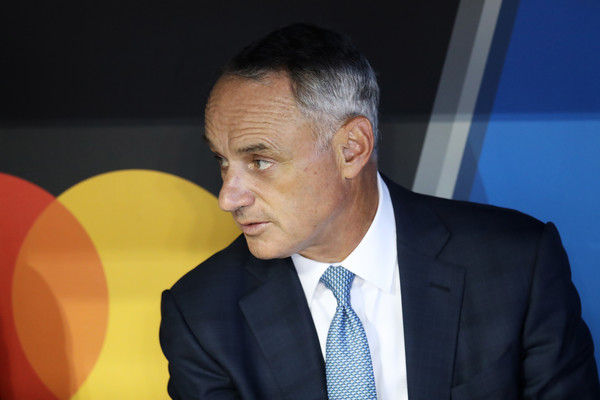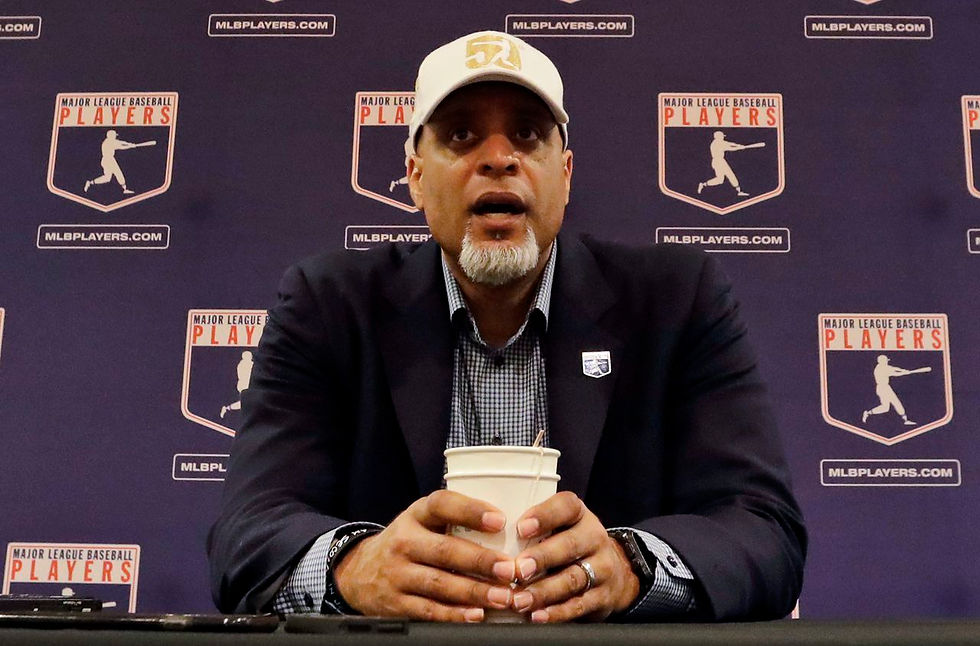To Concede or Not to Concede
- Jacob Bleiweis
- Jun 11, 2020
- 6 min read

(Rob Carr/Getty Images North America)
It has been a crazy couple of months in America and around the world, but the impending return of the NBA and NHL have been a beam of optimism shining through the cloudy horizon. However, cynicism, hopelessness, and distrust are more fitting descriptors when talking about MLB’s potential return. With the players’ most recent proposal, which will eventually be rejected by the players, a season that meets fans’ expectations is unlikely.
So how did we get here? What have the players and owners done to try and remedy their differences into a suitable agreement to give fans the season that they deserve?
To begin, on March 26, MLB and the MLB Players Association (MLBPA) came to an agreement, buying them some time to decide how to proceed with the season amid the coronavirus pandemic. This agreement gave MLB the chance to determine a schedule at a later time “using best efforts to play as many games as possible, while taking into account player safety and health, rescheduling needs, competitive considerations, stadium availability, and the economic feasibility of various alternatives.” It also stated that players would receive full prorated salaries, which means that a player would get paid their normal salary multiplied by the number of games played divided by 162 (normal salary times the percent of games played).
MLB’s first official proposal fell remarkably short of the MLBPA’s desires, but it was only the first offer in what was expected to be an arduous negotiation process. It included an 82 game season with massive pay cuts, especially for the game’s higher paid players due to the scale of the pay cuts. According to ESPN’s Jeff Passan, a player making the league minimum ($563,500) would have a prorated salary based on an 82 game season of $285,228 and then have a 10% pay cut. This would result in a final salary of $256,706. The rest of the players’ salaries in this proposal go down as their prorated salary goes up:
$563,501 to $1 million paid at 72.5%
$1,000,001 to $5 million paid at 50%
$5,000,001 to $10 million paid at 40%
$10,000,001 to $20 million paid at 30%
$20,000,001 and up paid at 20%
This would result in Mike Trout, the highest-paid player in the league, who would normally make $37,666,666, only making $5,748,577 (based off a prorated salary of $19,065,843 from 82 games). This proposal also includes $200 million in playoff bonuses contingent on finishing each series ($25 million for the division series, $50 million for the league championship series, and $125 million for the World Series). The total compensation for players would be $1.23 billion.
The MLBPA, incredibly disappointed with MLB’s first proposal, made a counter-offer, calling for a 114-game season with fully prorated salaries. Under this plan, every MLB player would make about 70% of their regular salary for 2020. The plan also includes $100 million in salary to be deferred with interest for players who have original 2020 salaries of at least $10 million if the postseason does not happen because of a second wave of the pandemic. In this proposal, the total compensation for players would be $2.87 billion.
Generally in negotiations, the first offer is incredibly steep and you settle somewhere in the middle, but both sides’ first offers were absurd. The league has projected total revenue to be $2.75 billion (the union disagrees with this number though), so a total salary number of $2.87 billion, plus other expenses, would result in a hefty loss for the league. The mammoth pay cuts in the league’s first offer were laughable. Both offers were counterproductive to the negotiations.
Under the union’s plan, players could also choose not to play if they fear infection and receive service time. If a player qualifies as high risk or lives with a person who qualifies as high risk they would receive their salary in addition to service time.
As predicted, the owners rejected the players’ proposal, but before they presented an official counter-offer, reports circled that the owners were contemplating exercising their right to hold a 48-50 game season with fully prorated salaries. This would result in every player receiving around 30% of their original 2020 salary.
With this piece of leverage in their back pockets, the owners proposed a 76-game season to the players in which they would get paid 75% of their prorated salaries. Under this plan, the players would receive around 35% of their original full-season salaries. This would result in $1.432 billion in total compensation. However, $989 million would be guaranteed and $443 million would only be paid if the playoffs happen. Using MLB’s $2.75 billion revenue projection, this proposal would be more than 50-50 revenue split that the owners were considering offering, but never did offer, earlier in the process. However, not all of the players’ revenue would be guaranteed.
This proposal from the owners would allow high-risk players to not play and receive their salaries and service time. However, as Jorge Castillo of the LA Times reported, “MLB’s proposal includes a revision to the Operations Manual that says players would have to sign an ‘acknowledgment of risk’ before playing.” The Union said players may sign depending on the language, but it seems like the league wants to protect itself from liability if a player gets infected. The owners want the players to accept all of the risk without getting properly compensated for it, and if they do get sick, it’s on them, not the league.

(Tony Clark, Executive Director MLBPA, AP)
In the proposal that the players sent Tuesday night, the players offered an 89-game season with fully prorated salaries. This is a large drop from the 114-game season that the players proposed previously, and it lets the players receive around 55% of their original salaries. This proposal also involves the players sharing a pool of at least $50 million if there are no fans during the playoffs, which is aligned with the offer from the owners. Although this offer seems like a significant step in the right direction, MLB Network Insider Joel Sherman reported that an influential management person said that it did not move the ball at all.
An 89-game season means that it will end around October 10th, but the league wants the season to end in late September as usual. Ending in September means that the playoffs won’t interfere as much with the NFL, and will take place when the weather is nicer, so an 89-game season is a little too long, but it is moving in the right direction.
If the league and the union want an MLB season with more than 48 games, both sides will need to compromise more than they have, and it has already been a long month of negotiating. The first offer from the players was ludicrous, especially considering that the league has leverage with their ability to institute a 48-game season, but the owners have made little effort to compromise as well.
MLB is going to lose a massive amount of revenue this season, and the league cannot avoid this. This loss has to fall on both the players and the owners. However, the period for potential earnings is much longer for owners than players. A 2007 study from the University of Colorado at Boulder found that the average major league baseball career is 5.6 years. Owners own their team for much longer. This means that it will be considerably easier for owners to make up the lost revenue from this year than it will be for players, especially for players on the lower end of the salary spectrum.
Critics of the players have called them selfish for refusing to take massive pay cuts, urging them to look at grocery store workers, nurses, teachers, and other Americans who will also encounter risk in their profession but are not getting millions of dollars in compensation. However, they fail to find fault in the actions of the owners, who have personal net worths of hundreds of millions of dollars and could almost all sell their teams for $1 billion of profit. (The Marlins are the only franchise whose value has decreased under their current ownership group, led by Bruce Sherman and Derek Jeter. They bought the franchise for $1.2 billion in 2017, but it is worth only $980 million now.)
Anyone who has had the privilege of owning a baseball franchise for a decent amount of time has seen their asset increase in value dramatically since nearly all American sports franchises are guaranteed to increase in value as time goes on. So why do some consider the players to be selfish when owners are sitting in their ivory towers on significantly more wealth?
Even with this in mind, it is important to remember that MLB is a business, and businesses strive to earn as large a profit as possible. This means that there will have to be some concessions from both sides. A business can have a down year and survive, and even thrive, in following years. But the players cannot be over zealous in their negotiations, or they will get a 48-game season and 30% of their original salaries.
Right now, the owners are at 74 games with 75% prorated salaries, and the players are at 89 games with 100% prorated salaries, and I think a fair meeting place would be around 75 games with 100% prorated salary. Either everyone will be happy or no one will, which are both signs of a successful agreement.




Comments